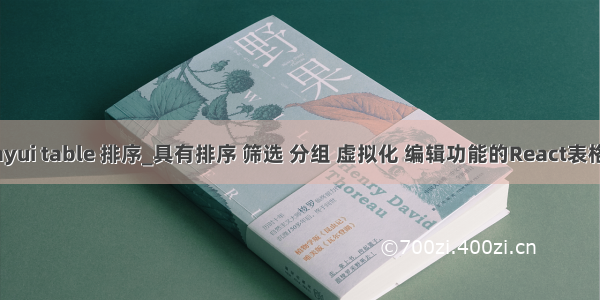
前言
element-plus@2.2.0后提供虚拟化表格组件,解决表格数据过大导致的卡顿等性能问题。相对于表格组件,用法上区别还是挺大的,尤其是一些附加的功能,例如排序、筛选、自定义单元格/表头渲染等等。
本文参照官网文档、示例,结合个人使用总结,演示虚拟化表格的基本使用,记录上述附加功能的基本实现。除组件的相关接口需要按照官网规范使用外,示例中的其它具体实现的方法仅作参考,提供使用思路。
创建了一个项目收纳本文的一些demos:
element-plus-tablev2-demo
element-plus-tablev2-demo (gitee)
一、Element Plus 表格基础
官方介绍:
“在前端开发领域,表格一直都是一个高频出现的组件,尤其是在中后台和数据分析场景。 但是,对于 Table V1来说,当一屏里超过 1000 条数据记录时,就会出现卡顿等性能问题,体验不是很好。
通过虚拟化表格组件,超大数据渲染将不再是一个头疼的问题。”
官方提示:
TIP
该组件仍在测试中,生产环境使用可能有风险。 若您发现了 bug 或问题,请于 GitHub 报告给我们以便修复。 同时,有一些 API 并未在此文档中提及,因为部分还没有开发完全,因此我们不在此提及。
即使虚拟化的表格是高效的,但是当数据负载过大时,网络和内存容量也会成为您应用程序的瓶颈。 因此请牢记,虚拟化表格永远不是最完美的解决方案,请考虑数据分页、过滤器等优化方案。
TIP
在 SSR 场景下,您需要将组件包裹在
<client-only></client-only>之中 (如: Nuxt) 和 SSG (例如: VitePress).
属性
详见官网,这里只说几点需要注意的地方
表格属性: width, height 必填(可使用AutoResizer组件使表格自动调整大小,使用方式参照官网)表格属性 columns 为列 column 的配置数组,这是与表格组件最大的差异之一column 的配置中,可定义很多之前定义在 column 模板中的属性column 的配置属性中,cellRenderer 自定义单元格渲染是最大的差异(模板 ----> js)
简单使用
表格组件el-table(TableV1):
<script setup>const columns = [{prop: 'name', label: 'Name', width: 100 },{prop: 'age', label: 'Age', width: 100 },{prop: 'gender', label: 'Gender', width: 100 },{prop: 'tel', label: 'Tel', width: 100 }]const tableData = [{name: '', age: '', gender: '', tel: '' },// ...]</script><template><el-table :data="tableData"><el-table-columnv-for="col in columns":key="col.prop":prop="col.prop":label="col.label":width="col.width"/></el-table></template>
虚拟化表格组件el-table-v2(TableV2):
<script setup>const columns = [{key: 'name', dataKey: 'name', title: 'Name', width: 100 },{key: 'age', dataKey: 'age', title: 'Age', width: 100 },{key: 'gender', dataKey: 'gender', title: 'Gender', width: 100 },{key: 'tel', dataKey: 'tel', title: 'Tel', width: 100 }]const tableData = [{name: '', age: '', gender: '', tel: '' },// ...]</script><template><el-table-v2:columns="columns":data="tableData":width="700":height="400"fixed/></template>
后续的示例基于element-plus@2.2.17
二、自定义单元格渲染
jsx/tsx 或 vue 渲染函数
注意,Element Plus 的虚拟化表格组件(TableV2)提供的自定义单元格、表头单元格渲染器都要求返回VNode。需要使用jsx/tsx或者vue 渲染函数实现。如无需使用上述两个单元格渲染器,仅作基本数据展示、排序等基本功能的话,可以像 TableV1 一样直接在 vue 单文件组件内使用。
准备工作
本文采用jsx实现, Vue CLI 创建的项目可直接在vue单文件组件的 script 标签中添加 lang=“jsx” (<script setup lang="jsx">)
“
create-vue和 Vue CLI 都有预置的 JSX 语法支持。如果你想手动配置 JSX,请参阅 @vue/babel-plugin-jsx 文档获取更多细节。”
jsx用法可参考:Vue 3 Babel JSX 插件
vue官网 - 渲染函数 & JSX - JSX / TSX
element-plus虚拟化表格组件el-table-v2渲染自定义组件的其中两种方式(js和jsx)及注意事项
在Vue中使用JSX,很easy的
需掌握最基本的 插值、v-if、v-for、v-on、事件修饰符、组件的 jsx 语法,以及组件的插槽语法
Element Plus官方文档:
Element Plus - Virtualized Table 虚拟化表格
需了解该组件的常用属性方法、Column属性
本节的重点是单元格自定义渲染,在于cellRenderer方法,其参数类型如下:
type CellRenderProps<T> = {cellData: Tcolumn: Column<T>columns: Column<T>[]columnIndex: numberrowData: anyrowIndex: number}
分别为 单元格值、项、所有项、项下标、行数据、行下标
渲染方式对比(el-table vs el-table-v2)
el-table中常用的自定义单元格渲染方式(定义在表格 column 模板中):
<el-table :data="tableData"><el-table-columnv-for="col in columns":key="col.prop":prop="col.prop":label="col.label":width="col.width"><template #default="scope"><!-- 自定义单元格渲染 --><el-tag v-if="col.prop === 'tag'">{{ scope.row[col.prop] }}</el-tag><template v-else-if="col.prop === 'link'"><router-linkv-if="!!scope.row.id":to="{ name: 'TargetRouteName', params: { id: scope.row.id } }">{{ scope.row[col.prop] }}</router-link><span v-else>{{ scope.row[col.prop] }}</span></template><template v-else>{{ scope.row[col.prop] }}</template></template></el-table-column></el-table>
el-table-v2中常用的自定义单元格渲染方式(定义在 column 配置列表中):
vue单文件组件需要在script中加上lang="jsx"
<script lang="jsx" setup>const columns = [{key: 'link',title: 'Link',dataKey: 'link',width: 100,cellRenderer: ({cellData, rowData }) => (<a href={rowData.link } target="_blank">Go</a>)},// ...]</script>
实例列举
为了对照,会分别放上el-table与el-table-v2的自定义单元格渲染代码
为了精简代码,下述el-table-v2的示例均只展示cellRenderer函数
组件
<template v-else-if="col.prop === 'gene'"><router-linkv-if="scope.row.id && scope.row.view &&(scope.row.view?.includes($store.getters.userId) || $checkRolePermission(scope.row.view))":to="{ name: 'Target', params: { tid: scope.row.id } }"class="gene-text">{{ scope.row[col.prop] || '-' }}</router-link><span v-else class="gene-text">{{ scope.row[col.prop] || '-' }}</span></template>
const cellRenderer = ({cellData, rowData: row }) => {const tmp = row.id && row.view && (row.view?.includes($store.getters.userId) || $checkRolePermission(row.view))return tmp? <router-linkto={{name: 'Target', params: {tid: row.id } } }class="gene-text">{cellData ?? '-' }</router-link>: <span class="gene-text">{cellData ?? '-' }</span>}
包含了插值、v-if、组件。全局注册的组件可直接在 jsx 中使用
v-for
<template v-if="col.prop === 'result'"><router-linkclass="gene-source-tag"v-for="tag in scope.row[col.prop]":to="{ name: 'TargetAnalysis', params: { tid: scope.row.id, type: tag } }"><el-tag>{{ tag }}</el-tag></router-link></template>
const cellRenderer = ({cellData, rowData: row }) => {return <>{cellData?.map(tag => (<router-linkclass="gene-source-tag"to={{name: 'TargetAnalysis', params: {tid: row.id, type: tag } } }><el-tag>{tag }</el-tag></router-link>)) ?? ''}</>}
包含 v-for、组件、空标签。若并未全局引入Element Plus,需手动引入相关组件,其它自定义组件同样如此。
三、排序
介绍
TableV1 组件排序的实现过程:
设置el-table-column的sortable属性为true即可。
多个排序间相互独立
TableV2 排序的实现在我看来是“自由度很高”的,除了根据单项排序表格外,它还提供了一种叫“受控排序”的东西(可以实现多重排序):
首先,排序值只有两种,升/降序。清空排序需要手动清空记录排序状态的变量;
其次,组件提供了排序监听事件(@column-sort),但具体的排序方法需自行定义;
再次,不同于 TableV1 同时只进行一项排序,TableV2 允许多重排序。它可以记录所有可排序项的排序状态,但如何实现多重排序需要你自己在监听事件中实现。(自由度很高,一方面需要手动实现多重排序方法,另一方面需要通过管理排序状态变量控制表头UI上的三种状态: 升/降/无。为了避免UI上的疑惑,这两方面需要协调一致)
关键属性、事件、方法说明
先放上从官网上粘过来的相关的属性、事件、方法说明,方便对照后续示例参考
TableV2属性TableV2事件
Column属性
相关类型
type KeyType = string | number | symboltype ColumnSortParam<T> = {column: Column<T>; key: KeyType; order: SortOrder }enum SortOrder {ASC = 'asc',DESC = 'desc',}type SortBy = {key: KeyType; Order: SortOrder }type SortState = Record<KeyType, SortOrder>
使用示例(属性、事件、方法)
示例只保留了最基本的部分,方便理解如何使用。第三小节提供了完整 demo codepen 链接,可在线调试
单项排序
一般想要的就是表格若干项可以排序,但只进行单项排序
<el-table-v2:sort-by="sortState"@column-sort="onSort".../>
// 自行编写排序事件处理方法const handleSort = () => {}// 记录排序状态, key: 排序项的key, order: 升/降序const sortState = ref({key: "no", order: 'asc' });// 监听排序事件const onSort = ({key, order }) => {handleSort()sortState.value = {key, order };};
多重排序
举个例子,有个人员表,希望按城市排序,同一城市的按性别排序,同一性别的按年龄排序
<el-table-v2v-model:sort-state="sortState"@column-sort="onSort".../>
// 事件处理方法:自行根据 sortState 实现多重排序const handleSort = () => {}// 以键值对形式记录排序状态const sortState = ref({city: 'desc',gender: 'asc',age: 'asc'});// 监听排序事件const onSort = ({key, order }) => {handleSort()sortState.value[key] = order;};
在线演示
el-table-v2 单项排序 demo
el-table-v2 多重排序 demo
四、筛选/过滤器
介绍
类似于自定义单元格渲染,实现筛选需要通过自定义表头单元格渲染实现
官方示例是在可筛选的表头单元格中添加显示为筛选图标的弹出框(el-popover组件),弹出框内显示可筛选选项,选项列表需要自行计算好。筛选的执行也需要自行监听实现,和排序一样,自由度非常高~
自定义表头单元格渲染:
const columns = [{// key, dataKey, title, ...headerCellRenderer: (props) => {return props.column.title}},// ...]
Column属性
类型
type HeaderRenderProps<T> = {column: Column<T>columns: Column<T>[]columnIndex: numberheaderIndex: number}
通过在headerCellRenderer方法中返回一个的 VNode 实现自定义表头单元格渲染
使用示例
筛选/过滤器的高自由度决定了它的具体实现方式因人而异,以下示例仅作参考。同第二节一样,示例使用的是 jsx
实现过程
首先,需要标识哪些column需要添加筛选功能,延续个人在TableV1中的使用习惯,在columns数组中添加相关属性,filterable标识该项是否可筛选,filterMethod指定筛选方法
import {generalArrFilterHandler } from '@/use/el-table-v2-utils'const columnData = ref([{key: "no", dataKey: "no", title: "No.", width: 60 },{key: "code", dataKey: "code", title: "code", width: 80 },{key: "name", dataKey: "name", title: "name", width: 80 },{key: "age", dataKey: "age", title: "Age", width: 60 },{key: "gender", dataKey: "gender", title: "gender", width: 80, filterable: true },{key: "city", dataKey: "city", title: "City", width: 80, filterable: true },{key: "tags", dataKey: "tags", title: "Tags", width: 150, filterable: true, filterMethod: generalArrFilterHandler }]);
为了避免对 TableV2 的潜在影响,表格组件所使用的 columns 数组中过滤掉一些不必要的属性,headerCellRenderer方法也需要定义在此。
示例中,定义了一个弹出框,点击筛选图标显示弹出框,弹出框内是一个多选框组,确定后进行筛选
const columns = columnData.value.map(col => {return {key: col.dataKey,title: col.title,dataKey: col.dataKey,width: col.width ?? 100,headerCellRenderer: (props) => {if(!col.filterable) return props.column.titlereturn <div class="tbv2-th-filter"><span class="th-cell">{props.column.title }</span><el-popover trigger="hover" {...{width: 200 }}>{{default: () => (<div class="filter-wrapper"><div class="filter-group"><el-checkbox-group v-model={filterableCols[col.dataKey].selected }>{filterableCols[col.dataKey].list.map(f => <el-checkbox key={f.value } label={f.value }>{f.text }</el-checkbox>)}</el-checkbox-group></div><div class="el-table-v2__demo-filter"><el-button text onClick={onFilter }>Confirm</el-button><el-button text onClick={() => onReset(col.dataKey) }>Reset</el-button></div></div>),reference: () => (<svgviewBox="0 0 1024 1024"xmlns="/2000/svg"width="14" height="14" style="cursor:pointer"><path fill="currentColor" d="M735.086 796.233c0-15.58 12.727-28.818 28.891-28.818h230.4a29.257 29.257 0 0 1 28.818 28.818 28.891 28.891 0 0 1-28.745 28.818H763.977a29.257 29.257 0 0 1-28.818-28.818zm0-127.927c0-15.506 12.727-28.745 28.891-28.745h230.4a29.257 29.257 0 0 1 28.818 28.745 28.891 28.891 0 0 1-28.745 28.819H763.977a29.257 29.257 0 0 1-28.818-28.819zm28.891-156.672h230.4a29.257 29.257 0 0 1 28.818 28.819 28.891 28.891 0 0 1-28.745 28.818H763.977a29.257 29.257 0 0 1-28.818-28.818 29.257 29.257 0 0 1 28.818-28.819zM901.632 0c50.176 0 122.149 49.006 121.051 127.927 1.098 35.694-13.897 66.267-42.642 96.768-216.064 189.586-300.178 227.62-306.468 285.257-5.267 45.495-1.829 472.357-2.926 478.135a39.497 39.497 0 0 1-5.778 22.455c-18.432 18.432-37.45 12.141-47.25 4.023-72.046-58.734-232.741-189.514-251.173-228.133-21.358-41.472-13.24-126.757-13.24-276.48 0-34.085-253.512-235.154-308.296-285.257C31.744 210.285 0 181.54 0 128 0 49.59 63.927 0 134.802 0h766.83zM76.069 164.79c1.682 2.341 4.022 5.12 6.875 8.047l8.63 8.63-3.437-3.437a9235.017 9235.017 0 0 0 147.53 125.074l14.92 12.654c134.29 115.2 167.132 147.456 167.132 194.706 0 27.648 0 51.273-.585 88.137-1.756 114.103 0 145.774 8.045 161.353 3.438 6.876 47.836 49.518 108.325 101.961l17.262 14.41c32.914 27.648 57.051 54.125 57.051 51.273V747.813c0-139.996.585-221.184 3.438-244.298 1.755-13.165 5.193-25.892 10.386-38.034 15.58-35.108 40.96-59.246 105.472-111.689l89.234-72.046c40.375-34.596 81.262-69.12 121.637-104.887l-4.608 4.096c19.017-20.187 25.893-35.181 25.307-53.613C959.27 93.915 926.501 64 901.632 64h-766.83c-41.472 0-70.875 26.478-70.875 63.927 0 14.994 4.023 25.892 12.142 36.864z" /></svg>)}}</el-popover></div>}}})
别忘了,筛选项可筛选列表也需要自行计算出来。filterableCols是用来存储可筛选项相关信息的,示例中,定义了默认的筛选方法
import {generalFilterHandler } from '@/use/el-table-v2-utils'const originData = ref([]);const tableData = ref([]);/*** 筛选信息列表* props:* - {Array} list 可筛选值列表* - {Array} selected 已勾选列表* - {Function} [filterMethod] 筛选方法*/const filterableCols = reactive(columnData.value.filter(c => c.filterable).reduce((prev,curr) => {prev[curr.dataKey] = {selected: [],list: [],filterMethod: curr.filterMethod ?? generalFilterHandler}return prev}, {}))// 自动获取各项筛选列表const getFiltersFromResp = () => {for(let dataKey in filterableCols) {let listif(dataKey === 'tags') {// tags 项可筛选列表固定list = ['developer','Ph.D','Bachelor','Master','CEO','HRBP','HR'].map(p1 => ({text: p1, value: p1 }))} else {// 其它项取所有非重复项list = originData.value.map(p => p[dataKey]).filter(Boolean)// 去重、转对象list = [...new Set(list)].map(p1 => ({text: p1, value: p1 }))}filterableCols[dataKey].list = listfilterableCols[dataKey].selected = []}}// const getTableData = () => { ... }const getData = (total) => {getTableData(total).then((res) => {originData.value = res ?? [];tableData.value = originData.value;getFiltersFromResp()});};
筛选方法需自行定义
const onFilter = () => {const allFilters = Object.entries(filterableCols).filter(([_,configs]) => {return configs.selected?.length > 0})tableData.value = originData.value.filter(p => {return allFilters.every(([dataKey,configs]) => {return !configs.filterMethod || configs.filterMethod(p[dataKey], configs.selected)})})};const onReset = (dataKey) => {filterableCols[dataKey].selected = []onFilter();};
完整代码
<script lang="jsx" setup>import {ref, reactive, onMounted } from "vue"import {generalFilterHandler, generalArrFilterHandler } from '@/use/el-table-v2-utils'onMounted(() => {getData()})const originData = ref([]);const tableData = ref([]);const columnData = ref([{key: "no", dataKey: "no", title: "No.", width: 60 },{key: "code", dataKey: "code", title: "code", width: 80 },{key: "name", dataKey: "name", title: "name", width: 80 },{key: "age", dataKey: "age", title: "Age", width: 60 },{key: "gender", dataKey: "gender", title: "gender", width: 80, filterable: true },{key: "city", dataKey: "city", title: "City", width: 80, filterable: true },{key: "tags", dataKey: "tags", title: "Tags", width: 150, filterable: true, filterMethod: generalArrFilterHandler }]);const columns = columnData.value.map(col => {return {key: col.dataKey,title: col.title,dataKey: col.dataKey,width: col.width ?? 100,headerCellRenderer: (props) => {if(!col.filterable) return props.column.titlereturn <div class="tbv2-th-filter"><span class="th-cell">{props.column.title }</span><el-popover trigger="hover" {...{width: 200 }}>{{default: () => (<div class="filter-wrapper"><div class="filter-group"><el-checkbox-group v-model={filterableCols[col.dataKey].selected }>{filterableCols[col.dataKey].list.map(f => <el-checkbox key={f.value } label={f.value }>{f.text }</el-checkbox>)}</el-checkbox-group></div><div class="el-table-v2__demo-filter"><el-button text onClick={onFilter }>Confirm</el-button><el-button text onClick={() => onReset(col.dataKey) }>Reset</el-button></div></div>),reference: () => (<svgviewBox="0 0 1024 1024"xmlns="/2000/svg"width="14" height="14"style={{cursor: 'pointer',color: filterableCols[col.dataKey].selected?.length > 0 ? '#387FE5' : 'inherit'} }><path fill="currentColor" d="M735.086 796.233c0-15.58 12.727-28.818 28.891-28.818h230.4a29.257 29.257 0 0 1 28.818 28.818 28.891 28.891 0 0 1-28.745 28.818H763.977a29.257 29.257 0 0 1-28.818-28.818zm0-127.927c0-15.506 12.727-28.745 28.891-28.745h230.4a29.257 29.257 0 0 1 28.818 28.745 28.891 28.891 0 0 1-28.745 28.819H763.977a29.257 29.257 0 0 1-28.818-28.819zm28.891-156.672h230.4a29.257 29.257 0 0 1 28.818 28.819 28.891 28.891 0 0 1-28.745 28.818H763.977a29.257 29.257 0 0 1-28.818-28.818 29.257 29.257 0 0 1 28.818-28.819zM901.632 0c50.176 0 122.149 49.006 121.051 127.927 1.098 35.694-13.897 66.267-42.642 96.768-216.064 189.586-300.178 227.62-306.468 285.257-5.267 45.495-1.829 472.357-2.926 478.135a39.497 39.497 0 0 1-5.778 22.455c-18.432 18.432-37.45 12.141-47.25 4.023-72.046-58.734-232.741-189.514-251.173-228.133-21.358-41.472-13.24-126.757-13.24-276.48 0-34.085-253.512-235.154-308.296-285.257C31.744 210.285 0 181.54 0 128 0 49.59 63.927 0 134.802 0h766.83zM76.069 164.79c1.682 2.341 4.022 5.12 6.875 8.047l8.63 8.63-3.437-3.437a9235.017 9235.017 0 0 0 147.53 125.074l14.92 12.654c134.29 115.2 167.132 147.456 167.132 194.706 0 27.648 0 51.273-.585 88.137-1.756 114.103 0 145.774 8.045 161.353 3.438 6.876 47.836 49.518 108.325 101.961l17.262 14.41c32.914 27.648 57.051 54.125 57.051 51.273V747.813c0-139.996.585-221.184 3.438-244.298 1.755-13.165 5.193-25.892 10.386-38.034 15.58-35.108 40.96-59.246 105.472-111.689l89.234-72.046c40.375-34.596 81.262-69.12 121.637-104.887l-4.608 4.096c19.017-20.187 25.893-35.181 25.307-53.613C959.27 93.915 926.501 64 901.632 64h-766.83c-41.472 0-70.875 26.478-70.875 63.927 0 14.994 4.023 25.892 12.142 36.864z" /></svg>)}}</el-popover></div>}}})/*** 筛选信息列表* props:* - {Array} list 可筛选值列表* - {Array} selected 已勾选列表* - {Function} [filterMethod] 筛选方法*/const filterableCols = reactive(columnData.value.filter(c => c.filterable).reduce((prev,curr) => {prev[curr.dataKey] = {selected: [],list: [],filterMethod: curr.filterMethod ?? generalFilterHandler}return prev}, {}))const onFilter = () => {const allFilters = Object.entries(filterableCols).filter(([_,configs]) => {return configs.selected?.length > 0})tableData.value = originData.value.filter(p => {return allFilters.every(([dataKey,configs]) => {return !configs.filterMethod || configs.filterMethod(p[dataKey], configs.selected)})})};const onReset = (dataKey) => {filterableCols[dataKey].selected = []onFilter();};const tagList = ['developer','Ph.D','Bachelor','Master','CEO','HRBP','HR']// 自动获取各项筛选列表const getFiltersFromResp = () => {for(let dataKey in filterableCols) {let listif(dataKey === 'tags') {// tags 项可筛选列表固定list = tagList.map(p1 => ({text: p1, value: p1 }))} else {// 其它项取所有非重复项list = originData.value.map(p => p[dataKey]).filter(Boolean)// 去重、转对象list = [...new Set(list)].map(p1 => ({text: p1, value: p1 }))}filterableCols[dataKey].list = listfilterableCols[dataKey].selected = []}}const getData = (total) => {getTableData(total).then((res) => {originData.value = res ?? []tableData.value = originData.valuegetFiltersFromResp()})}const getTableData = (total) => {if (!total) total = Math.floor(Math.random() * 2000 + 1000)return new Promise((resolve, reject) => {resolve(Array.from({length: total }).map((_, idx) => {return {no: idx + 1,code: Math.floor(Math.random() * 100000).toString(16),name: Math.floor(Math.random() * 100000).toString(16),age: Math.floor(Math.random() * 30 + 18),gender: Math.random() > 0.5 ? "男" : "女",city: ["北京", "上海", "深圳"][Math.floor(Math.random() * 3)],tags: tagList.sort((a,b) => Math.random() - 0.5).slice(0, Math.floor(Math.random() * 4))}}))})}</script><template><h3>el-table-v2 筛选/过滤器 demo</h3><el-auto-resizer><template #default="{ height, width }"><el-table-v2:columns="columns":data="tableData":width="width":height="666":fixed="true"/></template></el-auto-resizer><div>Total: {{ tableData.length }}</div><el-button @click="getData()">刷新表格数据</el-button></template>
el-table-v2-utils.js:
/*** element-plus TableV2 筛选方法* @param {string} value 单元格数值* @param {string|Array} filters 已选筛选值或筛选值列表* @returns {boolean}*/export function generalFilterHandler(value, filters) {if(filters instanceof Array)return filterHandler(value, filters)return selectFilterHandler(value, filters)}/*** element-plus TableV2 筛选方法* @param {string} value 单元格数值* @param {Array} filters 已选筛选值列表* @returns {boolean}*/function filterHandler(value, filters) {return !filters?.length ? true : filters.includes(value)}/*** element-plus TableV2 筛选方法* @param {string} value 单元格数值* @param {string} filter 已选中的筛选值* @returns {boolean}*/function selectFilterHandler(value, filter) {return !filter && filter !== 0 || filter === value}/*** element-plus TableV2 筛选方法(单元格数值类型为数组)* @param {string|Array} value 单元格数值* @param {string|Array} filters 已选筛选值或筛选值列表* @returns {boolean}*/export function generalArrFilterHandler(value, filters) {if(!(value instanceof Array))return generalFilterHandler(value, filters)if(filters instanceof Array)return arrayFilterHandler(value, filters)return selectArrayFilterHandler(value, filters)}/*** element-plus TableV2 筛选方法(单元格数值类型为数组)* @param {string} value 单元格数值* @param {Array} filters 已选筛选值列表* @returns {boolean}*/function arrayFilterHandler(value, filters) {return !filters?.length ? true : filters.some(f => value?.includes(f))}/*** element-plus TableV2 筛选方法(单元格数值类型为数组)* @param {string} value 单元格数值* @param {string} filter 已选中的筛选值* @returns {boolean}*/function selectArrayFilterHandler(value, filter) {return !filter && filter !== 0 || value?.includes(filter)}
注意:对单元格数值的筛选也分为很多种
最常见的,就是判断与选中筛选值是否相等(多选时,是否包含在内)。其它常见的判断有包含、以…开头、以…结尾、等等其次,上例中有个特殊的项,tags,其数据类型为数组,需要筛选出存在 tag 包含在选中 tags 列表中的数据(如筛选条件为满足所有选中筛选值,筛选方法又不一样)其它更特殊些的筛选都需要自行拟好筛选方法需要注意,筛选方法参数与 TableV1 中的不同(示例中的自定义筛选方法是遍历一遍表格数据,而 TableV1 提供的筛选方法接口是对选中筛选值列表中的每个值,都遍历一遍表格数据。实质是一样的,只是方法参数类型不同而已)
另外,下一节方案二中,通过给源数据添加 hidden 标识是否通过筛选,无需单独记录筛选数据。改动也很简单,删除originData,onFilter中更新 hidden 属性值,表格绑定数据中进行筛选 hidden 不为 true 的。
其它附加功能
默认筛选值、筛选列表单选
如 TableV1 中提供的功能,有时候,我们需要添加默认筛选值;有些筛选项我们希望做成单选的形式。
接上例,可更新代码如下:
import CustomSelector from '@/components/custom-selector.vue'const columnData = ref([// ...{key: "gender",dataKey: "gender",title: "gender",width: 80,filterable: true,filterSingle: true,filteredValue: '男'},// ...]);/*** 筛选信息列表* props:* - {Array} list 可筛选值列表* - {Array} selected 已勾选列表(筛选值多选时使用)* - {string} singleSelect 已勾选值(筛选值单选时使用)* - {Function} [filterMethod] 筛选方法* - {Array} [filteredValue] 默认筛选值* - {boolean} [filterSingle] 筛选值单选?*/const filterableCols = reactive(columnData.value.filter(c => c.filterable).reduce((prev,curr) => {prev[curr.dataKey] = {selected: [],list: [],singleSelect: undefined,filterMethod: curr.filterMethod ?? generalFilterHandler,filteredValue: curr.filteredValue,filterSingle: curr.filterSingle ?? false}return prev}, {}))const onFilter = () => {const allFilters = Object.entries(filterableCols).filter(([_,configs]) => {return configs.filterSingle? ![null,undefined].includes(configs.singleSelect): configs.selected?.length > 0})tableData.value = originData.value.filter(p => {return allFilters.every(([dataKey,configs]) => {return !configs.filterMethod ||configs.filterMethod(p[dataKey], configs.filterSingle ? configs.singleSelect : configs.selected)})})};// 自动获取各项筛选列表const getFiltersFromResp = () => {for(let dataKey in filterableCols) {// ...// 根据是否多选,获取对应默认排序(值/列表)filterableCols[dataKey].selected = !filterableCols[dataKey].filterSingle? filterableCols[dataKey].filteredValue instanceof Array? filterableCols[dataKey].filteredValue: []: []filterableCols[dataKey].singleSelect = filterableCols[dataKey].filterSingle? typeof filterableCols[dataKey].filteredValue !== 'object'? filterableCols[dataKey].filteredValue: undefined: undefined}}const columns = columnData.value.map(col => {return {key: col.dataKey,title: col.title,dataKey: col.dataKey,width: col.width ?? 100,headerCellRenderer: (props) => {if(!col.filterable) return props.column.titlereturn <div class="tbv2-th-filter"><span class="th-cell">{props.column.title}</span><el-popover trigger="hover" {...{width: 200 }}>{{default: () => {return filterableCols[col.dataKey].filterSingle? <CustomSelectorv-model={filterableCols[col.dataKey].singleSelect }onChange={onFilter }list={filterableCols[col.dataKey].list }/>: <div class="filter-wrapper"><div class="filter-group"><el-checkbox-group v-model={filterableCols[col.dataKey].selected }>{filterableCols[col.dataKey].list.map(f => <el-checkbox key={f.value } label={f.value }>{f.text }</el-checkbox>)}</el-checkbox-group></div><div class="el-table-v2__demo-filter"><el-button text onClick={onFilter }>Confirm</el-button><el-button text onClick={() => onReset(col.dataKey) }>Reset</el-button></div></div>},reference: () => (<svgviewBox="0 0 1024 1024"xmlns="/2000/svg"width="14" height="14"style={{cursor: 'pointer',color: (filterableCols[col.dataKey].filterSingle? ![null,undefined].includes(filterableCols[col.dataKey].singleSelect): filterableCols[col.dataKey].selected?.length > 0) ? '#387FE5' : 'inherit'} }><path fill="currentColor" d="M735.086 796.233c0-15.58 12.727-28.818 28.891-28.818h230.4a29.257 29.257 0 0 1 28.818 28.818 28.891 28.891 0 0 1-28.745 28.818H763.977a29.257 29.257 0 0 1-28.818-28.818zm0-127.927c0-15.506 12.727-28.745 28.891-28.745h230.4a29.257 29.257 0 0 1 28.818 28.745 28.891 28.891 0 0 1-28.745 28.819H763.977a29.257 29.257 0 0 1-28.818-28.819zm28.891-156.672h230.4a29.257 29.257 0 0 1 28.818 28.819 28.891 28.891 0 0 1-28.745 28.818H763.977a29.257 29.257 0 0 1-28.818-28.818 29.257 29.257 0 0 1 28.818-28.819zM901.632 0c50.176 0 122.149 49.006 121.051 127.927 1.098 35.694-13.897 66.267-42.642 96.768-216.064 189.586-300.178 227.62-306.468 285.257-5.267 45.495-1.829 472.357-2.926 478.135a39.497 39.497 0 0 1-5.778 22.455c-18.432 18.432-37.45 12.141-47.25 4.023-72.046-58.734-232.741-189.514-251.173-228.133-21.358-41.472-13.24-126.757-13.24-276.48 0-34.085-253.512-235.154-308.296-285.257C31.744 210.285 0 181.54 0 128 0 49.59 63.927 0 134.802 0h766.83zM76.069 164.79c1.682 2.341 4.022 5.12 6.875 8.047l8.63 8.63-3.437-3.437a9235.017 9235.017 0 0 0 147.53 125.074l14.92 12.654c134.29 115.2 167.132 147.456 167.132 194.706 0 27.648 0 51.273-.585 88.137-1.756 114.103 0 145.774 8.045 161.353 3.438 6.876 47.836 49.518 108.325 101.961l17.262 14.41c32.914 27.648 57.051 54.125 57.051 51.273V747.813c0-139.996.585-221.184 3.438-244.298 1.755-13.165 5.193-25.892 10.386-38.034 15.58-35.108 40.96-59.246 105.472-111.689l89.234-72.046c40.375-34.596 81.262-69.12 121.637-104.887l-4.608 4.096c19.017-20.187 25.893-35.181 25.307-53.613C959.27 93.915 926.501 64 901.632 64h-766.83c-41.472 0-70.875 26.478-70.875 63.927 0 14.994 4.023 25.892 12.142 36.864z" /></svg>)}}</el-popover></div>}}})
CustomSelector组件:单选列表(展开的 el-select )
<script setup>const props = defineProps({modelValue: {default: '' },list: {type: Array, default: [] }})const emit = defineEmits(['change','update:modelValue'])function handleOptionClick(val) {if(props.modelValue === val) returnemit('update:modelValue', val)emit('change', val)}</script><template><div class="wrap"><divv-for="option in list":key="option.value":class="['item', { active: modelValue === option.value }]"@click="handleOptionClick(option.value)">{{ option.text }}</div></div></template><style lang="scss" scoped>.wrap {width: 100%;font-size: 14px;color: #666;.item {line-height: 32px;padding: 0 12px;cursor: pointer;&.active {color: #387FE5;font-weight: bold;}&:hover {background-color: #f9f9f9;}}}</style>
多级表头
官方文档在 TableV2 上给出的说法是“表头分组”,效果同 TableV1 不大一样。
V1是通过<el-table-column>嵌套实现,意义明确、实现简单,创建一个嵌套的columns列表就可以。
V2的实现是通过表格组件提供的header插槽
<script setup>const CustomizedHeader = ({cells, columns, headerIndex }) => {return cells}</script><template><el-table-v2:columns="columns":data="tableData":width="666":height="666"><template #header="props"><CustomizedHeader v-bind="props" /></template></el-table-v2></template>
类型:
type HeaderSlotProps = {cells: VNode[]columns: Column<any>[]headerIndex: number}
官方给出的示例中,CustomizedHeader的生成过程非常sao,对理解造成了很大干扰
我的理解就是,官方已经把默认生成的表头 VNode 列表返回给我们了,我们自行处理。需要实现表头分级,并保持对齐
假设 cells 长度为5,也就是原有5个表头单元格,想要将第3、4个上加上一级表头
const CustomizedHeader = ({cells, columns, headerIndex }) => {const groupCells = []for(let i = 0, len = columns.length; i < len; i++) {if(i === 2) {const width = cells[i].props.column.width + cells[i+1].props.column.widthgroupCells.push(<divstyle={{width: `${width}px` }}><div>Group</div><div style="display:flex">{cells[i]}{cells[i+1]}</div></div>)i++} else {groupCells.push(cells[i])}}return groupCells}
上例返回的 VNode 数比原本少了一个,将第3、4个单元格放在一个自定义的 div 元素中去了。该元素的内容及样式均需要自行处理
多选时,不点击确定
单选组件设置了监听事件,无需点击确定即可触发筛选事件
而多选使用的多选框组,存储选中筛选值的变量是直接绑定到组件上的,示例中通过点击确定按钮手动触发筛选事件,不点击会导致的UI与实际筛选不符的问题
想到两种解决方案,一是使用多选框组提供的change事件,代价是可能会筛选过于频繁。另一种是创建一个变量存储前一次筛选状态,每次执行筛选前与当前筛选状态进行对比,相同则不执行筛选
方案一:更新headerCellRenderer
<el-checkbox-group v-model={ filterableCols[col.dataKey].selected }>
↓↓↓↓↓
<el-checkbox-group v-model={ filterableCols[col.dataKey].selected } onChange={ onFilter }>
方案二:
const prevFilters = ref([])const compareFilters = currFilters => {return prevFilters.value.length === currFilters.length&& prevFilters.value.every((f,idx) => {let [currDataKey,{selected: currSelected, singleSelect: currSingleSelect }] = currFilters[idx]currSelected = currSelected.slice(0).sort()return f.dataKey === currDataKey&& f.singleSelect === currSingleSelect&& f.selected.slice(0).sort().every((p,idx1) => p === currSelected[idx1])})}const onFilter = () => {// const allFilters = ...if(compareFilters(allFilters)) returnprevFilters.value = allFilters.map(([dataKey,configs]) => ({dataKey,selected: configs.selected,singleSelect: configs.singleSelect}))// ...};
五、排序、筛选同时使用
按前两节示例,排序、筛选当然可以同时实现,但需要处理数据上冲突
问题分析
两部分的示例中,都使用了 originData 记录表格原始数据:
如果不保存源数据,在排序中,不光无法置空排序、回归原顺序,不同排序项的历史排序影响也会持续下去,其实是难以预料的多重排序结果。筛选操作也变成了基于上一次筛选结果的筛选
const tableData = ref([])const originData = ref([])// handle sorttableData.value = originData.value.slice(0).sort(sortMethod)// handle filtertableData.value = originData.value.filter(filterMethod)
两者都是基于源表格数据进行排序、筛选。两个功能同时存在时,就有冲突了,会彼此干扰此前的操作。
解决方案
方案一:创建中间变量
额外创建一个变量tempData,用它记录筛选后的数据,tableData记录排序后的值
originData->tempData->tableData
originData更新时,tempData,tableData重置为originData筛选时,基于源数据筛选(originData->tempData),tableData重置为tempData排序时,基于tempData排序(tempData->tableData)
看起来有点绕,其实就两条依赖关系,添加两个相应的watch就可以了
<el-table-v2:data="tableData".../>
const tableData = ref([]) // 表格当前数据(排序、筛选后)const tempData = ref([]) // 中间变量,对源数据的筛选const originData = ref([]) // 表格源数据// 源数据更新 -> 更新筛选项各自的可筛选列表, 执行筛选watch(originData, (newVal) => {getFiltersFromResp()onFilter() // 执行筛选会更新 tempData})// 排序状态更新 | tempData 更新 -> 执行排序watch([sortState, tempData],([newState, newData]) => {// handle sort ( originData --sort--> tableData )const {key, order } = newState ?? {}// 数据为空 | 当前无排序,重置 tableDataif (!newData?.length || !key || !order) {tableData.value = newDatareturn}// ...tableData.value = newData.slice(0).sort(sortMethod)},{immediate: true })// handle filterconst onFilter = () => {// ...tempData.value = originData.value.filter(execFilter)}
方案二:源数据中添加筛选标识
筛选事件处理方法中,标识数据是否通过筛选(例如:添加 hidden 属性),与方案一相比,代码改动较小:
const tableData = ref([]) // 表格当前数据(排序、筛选后)// const tempData = ref([]) // 中间变量,对源数据的筛选const originData = ref([]) // 表格源数据// 源数据更新 -> 更新筛选项各自的可筛选列表, 执行筛选watch(originData, (newVal) => {getFiltersFromResp()onFilter()})// 排序状态更新 | originData 更新(包括 hidden 更新) -> 执行排序watch([sortState, originData], // [sortState, tempData],([newState, newData]) => {const {key, order } = newState ?? {}if (!newData?.length || !key || !order) {tableData.value = newData?.filter(p => !p.hidden) ?? [] // newDatareturn}// ...// tableData.value = newData.slice(0).sort(sortMethod)tableData.value = newData.filter(p => !p.hidden).sort(sortMethod)},{immediate: true, deep: true } // { immediate: true })const onFilter = () => {// ...// tempData.value = originData.value.filter(execFilter)originData.value.forEach(val => {val.hidden = !execFilter(val)})}
无中间变量,originData 添加 hidden 属性
相比之下,少一条依赖,代码简单一点。排序和筛选其实还都是基于源数据,只是使用 hidden 属性过滤 TableV2 的绑定数据
此方法同样可以应用在上一节单独使用筛选功能时,可以做到只使用源数据。
注意:
上例中为了监听到源数据 hidden 的变化,进行了深层监听。如果具体业务中有其它逻辑需要频繁改动源数据其它属性,而又不需要更新排序、筛选。可以不使用 watch 监听,避免无意义的执行排序、筛选
其他
为了突出排序已生效,可以加上样式
.el-table-v2__header-cell .el-table-v2__sort-icon.is-sorting {color:#387FE5}
六、总结
TableV2 只加载可见区域以及前后预加载(可设置)的“行”,纵向滚动后全部重新加载一遍。只要数据拿到了,表格的加载速度很快,对表格的一些响应式操作反应也很快,如果表格数据量可能在几千行及以上,很有必要换掉 TableV1。
TableV2 的问题在于它目前是全部重新加载,哪怕是纵向滑动了一行。
遇到的坑
当设置了动态高度行(estimated-row-height)时,可能会发生严重的卡顿现象!(与表格数据总数无关)
调试发现,目前 TableV2 每滚动一次就重新加载一次表格内及预加载的行数,总单元格过多时,会让体验感在上面的场景下变得极差。
以本人实际生产环境中的一个表格为例,表格一行有17个的单元格,一页显示20条数据,预先多加载的行数是2,每一次需要渲染 17*24=408 个单元格。连续纵向滚动会触发多次表格内容加载,轻微卡顿,有待优化,感觉可以提供一个属性作为连续滚动的节流处理开关。另一方面就是全部重新加载这个策略。
上面说的是正常流程,不正常的是,当设置了动态高度且超出设定高度的行数不少时,一次滚动就会重复触发四五次,再加上连续滚动。假设一个只触发三次的连续滚动,408 *4*3=4896 个单元格渲染。如果你够年轻,手速够快,轻松破万。再加上,某些自定义渲染的单元格够“大”够“重”,那。。。
这个问题应该是个 bug,希望后续版本能修复
















